This is the modification of the land that a glacier passes over. The terrain has not yet had time to recover from the last round of major glaciation, so the scars are still visible today.
Similar to weathering the glaciation process involves erosion, transport and deposition of sediment.
Rock Size
Large pieces of rock carried by a glacier and in contact with the base will cut groves in the bed rock surface, and smaller pieces will cut small lines in the surface. All will be roughly parallel with direction of movement.
Finer material (sand) will act like sandpaper and polish the bedrock surface. The movement down the rocks surface creates a wavy pattern with gradual slopes on the direction of upside movement and stronger dips in the downside direction. The upside is polished and the downside is often rougher with a history of removed material.
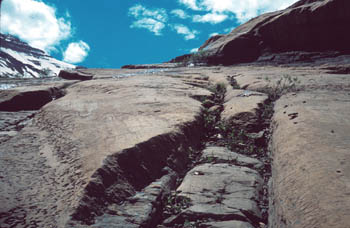
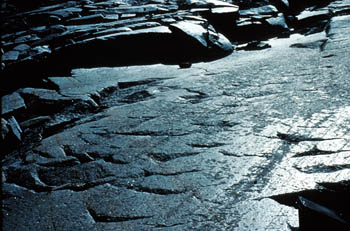

An "arete" is the ridge line between two cirques. It is very step with a knife like top. If three or more cirques cut into a mountain mass the result is a "horn".
The Matterhorn mountain in Switzerland is an excellent example. Glaciation yields some of the most striking scenery around, with sharp well defined boundaries.
Glacier valleys are "U" shaped and usually cut to a lower depth than any nearby natural valleys. Hence any side valleys entering a glacial valley will likely enter high up on the side.
Streams running down such valleys often create spectacular waterfalls into the glacial valley.

Photos USGS: Source
The glacier would have created a moraine at the bottom depositing a good deal of the moving mass. While active the ice would have carved deeply into the rock well below sea level. (Remember ice floats, but only 10%, 90% is still below sea level.)
During the last several ice ages various pats of North America have been covered with sheet ice. the same tell tale features found in valley glaciers are sometimes present on exposed hard rock surfaces. (The scratches, furrows, and polishing.) this aids geologist in determining the movement direction of various ice sheets.
If the ice sheet is frozen to the bed, then the markings are not as evident, and it more difficult to determine precise directions.
Unlike streams, glaciers do not sort their load. They can pickup and move almost any size rock or debris, they are not limited by their "currents" and velocity.
The load is usually concentrated at the base and sides as these are the high contact areas. Also unlike their stream counter parts, they don't necessarily wear the load into rounded masses as there is little churning or rock to rock contact on much of the rock mass.
The load in the base of a glacier is called "rock flour". The sediment and small rock fragments that are produced by glacier deposition or from streams caused by glaciers are called "drift".
At one end of the range is "till", and represents the rocks just as the glacier released them. They are normally random mixtures of fragments. They are often mixtures of sand and silt surrounding many larger fragments. The sand and silt comes from the bottom of the glacier and its grinding contact with the base stone, and the larger material is the load carried further up in the ice.
An "erratic" is a rock or collection of rocks that comes from some location not associated with the surrounding bed rock.
A moraine is the accumulated rock that is pushed to the front of a moving glacier. If the moraine is more or less smooth and not very high it is probably a ground moraine.
Ground moraine comes from the beneath the glacier and is usually fine material. It is formed from the materials that were probably used to sand and polish the bed rock.
An "end moraine" is deposited along the margin of a glacier. It is made up of debris carried in the upper portions of the glacier with some bottom material. It forms at the margins of the glacier. If it forms at the very end, terminus, then it is a "terminal moraine." If it forms along the edges then it is a "lateral moraine". Both terminal and lateral moraines are formed below the equilibrium line and continue to form as along as the glacier moves (in either direction).
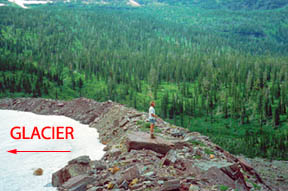
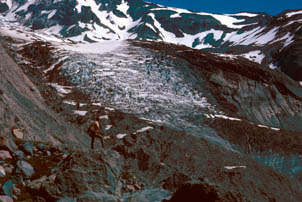
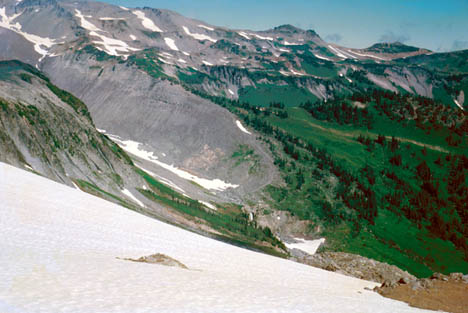 Photos USGS: Source
Photos USGS: Source| NEXT | TOC | PREV |